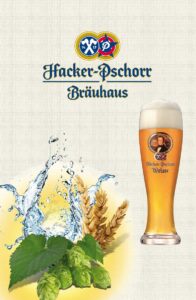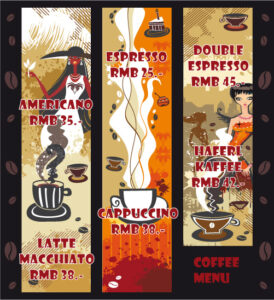The Menu
– There is a lot that goes into designing and to compile and to engineer a menu. First of all, you want it to be admirable and representable.
Another challenge is, due to the fact, that there are so many ways, occasions and types of businesses and contents – to find the best solution for a your specific operation.
- Classic – High End Restaurant – Brewhouse – Café …
- Stile – Format – Colours – Bords – Outside – Inside …
- Logo – Font – Background – Graphics – Content – Pages …
One part is to cast a beautifully designed and colourful cover that reflects the purpose of your business – the more difficult part is to compile the content of your menu.
Contact me if you have any questions to that subject!
|
Keep it simple and use the space efficiently
Utilize how the human brain perceives the different elements of your menu. In other words, you might want to learn about menu psychology.
Kind of menu
It must be clearly understood what kind of menu is required:
- Special event menu, Table d’hôte, A la carte
- Coffee, Afternoon Tea, Cocktail, Burger
- Children’s Menu, Wedding, Conference
- Vegetarian, Vegan, Diet, Brain Food
- Chefs Special, Daily Special, Bait of the Day, Business Lunch …
- Kind of meal – breakfast, luncheon, tea, supper or for a special function.
Menus will vary for the kind of establishment and type of guests
- Restaurant, Pub, Night Club, Brewhouse, Canteen, Café, Bar, Bistro …
- Young people, heavy steel worker, pensioners, football players, students, business men, …
In each case of the above groups of people and/or establishments there are certain foods which would suit one group but not necessarily the other.
The season of the year
If menus have to be compiled a long time in advance of the actual date of production, the season of the year should be considered –
- Weather, summer, winter
- Seasonal Foods
- Holidays, Christmas, Easter, St. Patrick’s Day
Prerequisite
- The capability of the service and the kitchen staff
- Size and equipment of the restaurant and the kitchen
Pricing
There is a lot you need to know about pricing! – Reading habits, currency signs, priming, …
The proposed charge per head is obviously an important factor to consider when selecting food for any menu.
A useful working rule with regards to the cost of food for a meal is to see that the food cost does not exceed 30% of the selling price.
- List most expensive products first. Alternatively you can list the products with the highest margin at the top.
- Offer your customers a deduction instead of an extra charge
- Even or Uneven Numbers – Round Numbers or Decimal Points. Here are a few ways to think about displaying prices: € 12,00 / €12 / 12,00 / €11,99 / 12 / 11,95 / Twelve Euro. All these ways of writing out a price have different associations.
- Lower your price to 11,99 because it seems lower, actually cheapens the perceived value your food. An exception here would be Fast-Food or Family-Friendly restaurants. A burger can be € 5,99 but a Filet Wellington in a fine dining restaurant should be written out as € 27 but not € 26,99.
- A menu without the currency signs and without any decimal points, would match with a simple, clear and clean menu. Relinquish currency signs (where eligible). Consider how symbols affect your menu price presentation.
The Paradox of Choice
The absurdity of decision making. A golden rule is that you should not have too many items on the menu. Statistically 80% of a restaurant sales come from 20% of its items.
Simplify matters!
Create more categories – Homemade Burgers, Noodles and Dumplings, Bait of the Day – and offer around seven options per food category, rather than have one category “Main Dishes” and list 25 items.
Supplies
Think of the availability of ingrediences, frequency of deliveries, size of storage and cooling divices a.s.o.
Create a well balanced menu
- Avoid the repetition of basic ingredients
- No repetition of words within one menu.
- Vary from dishes of a light nature to those of more substantial ones
- Texture of the items
- Be creative with garnishes and side dishes
- The sensible use of colour will always help the eye-appeal of a dish
Food values
- When a customer selects from an à la carte or table d’hôtel menu the composition of the meal is the customer’s own responsibility.
- When a set meal is offered for a special party or banquet the menu is usually more than adequate to fulfil the nutritional needs.
- Special attention should be paid, to the nutritional balance of meals for people engaged in light or heavy work.
- Meals served to school children, in hospitals, hostels or homes of the aged, all need thought on nutritional balance.
Finally the Wording of your menu items
- Trueness, correctness, understandable, clear, local wording, national, international
- Ordering decisions are based on the wording of the description of the dishes – so you better be exact and intriguingly with your item descriptions
- Do not promise anything the kitchen cannot stick to
- Showing that the dishes are handcrafted and details of how a dish is prepared will be highly appreciated by your guest
- Descriptive menu labels can increase sales by more than 25% – and they also result in higher customer satisfaction
And this also leads to more positive comments – under the premise that the item met the expectations.
When using international terms use it in its original form without translation – please do not try to translate foreign denomination.
Use the Full Power of Words
- Correct spelling and grammar
- Avoid a blending of languages (unless “Specials” that cannot or should not be translated or “technical terms” )
- Presentation – CI, CD, visual specials, clean, low maintenance
- Legal requirements: tax, allergens, nutrition, calories, weight
- Prep time, size of portions, further services
- Use words as “low, reduced, little, …” even if it is not related to the price
- Eye movement patterns are a tricky science – Golden Triangle – the eye goes to the centre, then the top right, and then the top left.
We are incredibly excited to share with you the good news:
Our F&B Consulting service is still here for you!
Contact me if you have any questions to that subject!
|




